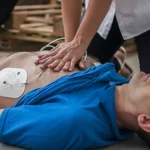Performing CPR on a drowning victim has some subtle differences compared to cardiac arrest victims. As the American Heart Association Guidelines and AHA training suggest, responders should perform two rescue breaths on drowning patients. However, some authorities don’t think rescue breaths are necessary.
The aim of CPR on drowning victims should be to expel water from the lungs, any way possible. Since rescue breaths can help accomplish this aim, American Health Care Academy supports the American Heart Association’s standpoint that responders should perform two rescue breaths on drowning victims.
This article discusses the differences involved in performing CPR on a drowning victim. Use it to identify if someone is drowning and act quickly and decisively in times of these emergencies.
American Health Care Academy believes we need more responders to help respond to the SCA crisis. Only about 46% of all SCA victims receive any CPR. That’s why we offer easy-enrollment CPR certification online classes that teach citizens of all backgrounds and ages how to perform CPR. Our CPR training classes provide both CPR certification and recertification and issue training supplies as well as group discounts.
Join American Health Care Academy today and experience CPR and first aid training that will help you save a life if you find yourself in a cardiac arrest emergency.
What Causes Drowning?
Drowning happens when someone can’t breathe underwater, and they intake water into their lungs. Intaking water into their lungs can cause them to suffocate and slip into cardiac arrest.
Identifying drowning victims is not always easy. They don’t always exhibit noticeable signs. Because it’s not always easy to locate drowning victims, you should understand the correct procedures to perform if you do find yourself in a drowning emergency. The quicker you act, the more you increase survival chances.
What’s the Best Way To Save a Drowning Victim?
The best way to save a drowning victim is to remove them from the water, call 911, and begin CPR. However, first, you have to understand how to detect a drowning victim.
For example, it might be difficult to tell whether a person is drowning in a crowded pool. The following indicators are the most common ways to detect if someone is drowning.
How To Detect a Drowning Victim
Drowning victims don’t always exhibit apparent signs. Sometimes, you might mistakingly believe they are staying afloat when they are failing to do so.
Panicky Movements
Panicky movements are the most common indicators that someone is drowning. People’s arms may flail in the water. They might also be making loud noises to convey struggle. However, this is not always the case, as drowning victims are often already exhausted and can’t muster up the energy to scream.
Head Back and Mouth Open
People struggling to keep their head above water will keep their head back and their mouth open, gasping for air. They do this because they are barely avoiding being completely submerged.
Difficulty Staying Above the Surface
You can notice a drowning victim by watching how often they keep their head above water. A drowning victim might be able to pop their head out of the water now and again, but they will not be able to sustain themselves above water.
Difficulty Kicking
Drowning victims will not be able to keep their feet kicking to stay above water. If you’re in a pool and you notice someone stop kicking and struggling to stay above water with their arms, or they go limp in the water, they need your attention.
Is CPR Performed Any Differently For Victims of Drowning?
A significant difference between regular CPR and drowning-victim CPR is that some people think drowning victims need mouth-to-mouth resuscitation. However, other experts say that mouth-to-mouth resuscitation is unnecessary for drowning victims and typical cardiac arrest victims.
In drowning victims, their cardiac arrest is caused by respiratory issues, which is why some schools of thought support rescue breaths. However, other scientists suggest that chest compressions can force out of their lungs just as much as rescue breaths.
What Makes CPR Different For Drowning Victims?
The drowning victim’s need for ventilation makes drowning victim CPR different from typical CPR. Drowning cardiac arrests cause asphyxia. Rescue breaths can help restore normal breathing in these cases.
CPR Steps For Drowning Victims
If you notice someone drowning, you can’t hesitate. Time is of the essence when it comes to delivering CPR to drowning victims. Only a few minutes of hypoxia can result in a permanent coma and death.
- Call 911.
- Attract the help of someone nearby.
- The bystander should preferably be a lifeguard. If not, try to attract the attention of the bystander who is nearest to you.
- If you are alone, follow these next steps.
- Remove the person from the water.
- Check for breathing.
- Check to see if the person’s chest is moving.
- Place your ear next to the victim’s nose and mouth to hear if they are breathing.
- If the person isn’t breathing, check their pulse.
- Check to see if they have a pulse for ten seconds. If they do not, begin CPR.
- Place the person on their back.
- For adults and children, place the heel of your hand in the center of the chest just above the nipple line. You can also interlace your hands and push one hand on top of the other. For infants, you should place two fingers on the breastbone.
- For adults and children, the chest compressions should be at least 2 inches deep. It’s better to have deeper compressions than not too deep. Chest compressions that are too shallow will fail to generate enough energy to restart the heart. For infants, chest compressions should only be one and a half inches deep.
- Regardless of age, perform the chest compressions at a 100 BPM rate. Let the chest recoil completely before administering the subsequent chest compression.
- Check to see if the victim is breathing after performing 30 chest compressions.
- Perform two rescue breaths.
- Repeat this process until help arrives.
- If the drowning victim starts breathing independently before help arrives, roll them into the recovery position. The recovery position means the victim is on their side, with their top leg and arm bent to help prop them up. Tilt the victim’s head back slightly to keep their airway open. Try to spare some clothes to keep the victim warm.
Since cardiac arrest from drowning is primarily caused by respiratory issues instead of cardiac problems, using an AED is less critical for drowning victims. However, if one is nearby, you should use it and apply your AED first-aid training.
Since the victim was just in the water, you will need to be especially careful that their person is dry before administering the shock. It is more critical to administer chest compressions and rescue breaths, so make sure you complete a few rounds of this before trying to use the AED.
Conclusion- How To Perform CPR On a Drowning Victim
Performing CPR on a drowning victim is similar to performing it on a cardiac arrest victim. However, there are a few differences to note. While some say rescue breaths aren’t crucial for drowning victims, the responder’s primary aim should be to get the air out of the victim’s lungs.
Both rescue breaths and chest compressions can help accomplish this aim. Using an AED is not as critical for drowning victims as it is for cardiac arrest victims. But if it is available, you can incorporate it into your life-saving measures.
Unfortunately, a Cleveland Clinic study found that only about half of all adults would feel comfortable administering CPR in an emergency. Luckily, online CPR certification makes it easy to advance your life-saving skills and fulfill your civic duty as a good Samaritan.
Contact American Health Care Academy today to schedule your CPR certification and help us continue the fight to save more lives.













